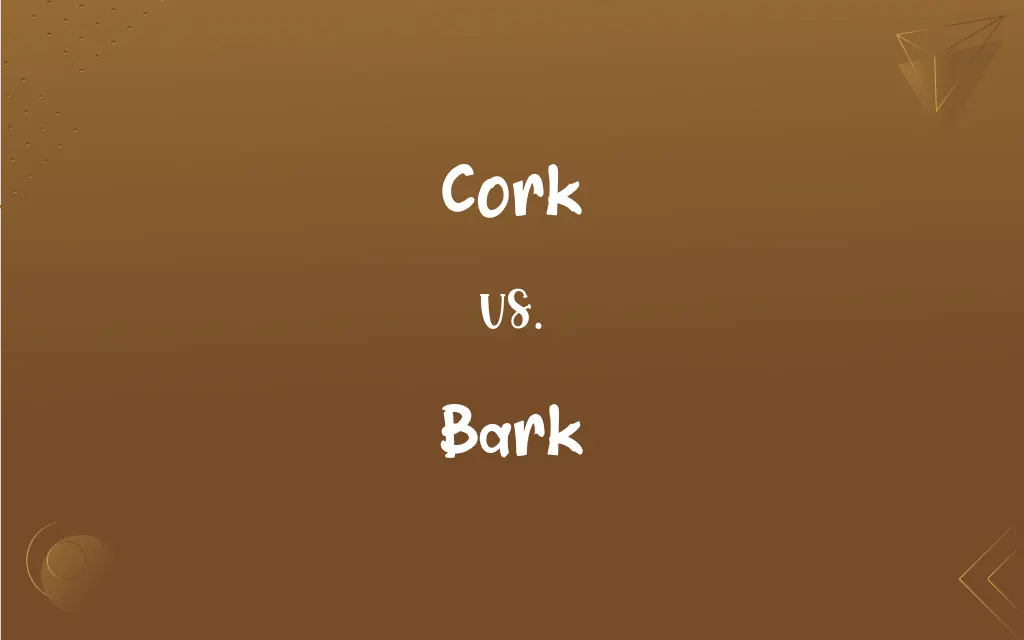Cork vs. Bark: What's the Difference?
Edited by Aimie Carlson || By Harlon Moss || Updated on October 28, 2023
Cork is a specific type of bark harvested from cork oak trees, used for insulation, seals, etc., while bark is the protective outer layer of all trees and shrubs.

Key Differences
Cork and bark both serve as protective layers, but cork is a specialized type of bark. Cork is harvested primarily from the cork oak tree and is renowned for its elasticity and impermeability. Bark, in contrast, is the general term for the outer covering of trees and shrubs, serving as a protective barrier against environmental elements.
Cork's unique cellular structure makes it an excellent insulator and shock absorber, leading to its widespread use in products like wine stoppers and bulletin boards. Bark, on the other hand, encompasses a wide variety of textures and densities, depending on the species of tree, and generally functions as a shield against pests, diseases, and weather conditions.
While cork is obtained specifically from the cork oak through a sustainable harvesting process that doesn't harm the tree, bark can come from any tree or shrub. Cork production is a meticulous process, ensuring the cork oak's health and longevity. Bark, in its broader definition, is not typically harvested but rather serves its purpose while remaining on the tree.
Both cork and bark contribute to the tree's survival but in different ways. Cork provides economic value and versatile applications in various industries, while bark, in its broader sense, is crucial for the overall health and protection of trees and shrubs.
Comparison Chart
Source
Specifically from cork oak trees.
From all trees and shrubs.
ADVERTISEMENT
Usage
Used in products like wine stoppers, flooring.
Mainly serves as a protective layer for the tree.
Economic Importance
High economic value, especially in wine industry.
Less direct economic value.
Harvesting
Harvested without harming the tree.
Not typically harvested, remains on the tree.
Physical Properties
Elastic, impermeable, lightweight.
Varies widely, generally tough and protective.
Cork and Bark Definitions
Cork
A city in southwest Ireland, known for its cultural heritage.
Cork is a vibrant city with a rich history in Ireland.
ADVERTISEMENT
Bark
To speak or shout sharply, often in anger.
The coach barked orders to the players during the game.
Cork
A term in fishing, referring to a float or bobber.
He attached a cork to his fishing line to monitor for bites.
Bark
The protective outer covering of trees and shrubs.
The bark of the oak tree was thick and rugged.
Cork
A material used for sealing bottles, especially wine bottles.
He carefully removed the cork from the vintage wine bottle.
Bark
A sound made by dogs and some other animals.
The dog's loud bark startled the visitors.
Cork
Small, rounded pieces used in badminton shuttlecocks.
The shuttlecock's cork base allows it to fly properly during the game.
Bark
A type of candy made with chocolate and nuts.
She made peppermint bark for the holiday party.
Cork
The lightweight, buoyant bark harvested from cork oak trees.
Cork is widely used for making bulletin boards.
Bark
A sailing ship with three masts.
The old bark glided gracefully across the ocean.
Cork
The lightweight elastic outer bark of the cork oak, used especially for bottle closures, insulation, floats, and crafts.
Bark
The harsh sound uttered by a dog.
FAQs
Can all trees produce cork?
No, cork specifically comes from the cork oak tree.
What is bark?
Bark is the protective outer layer of trees and shrubs.
Is bark used commercially?
Generally, no, but some bark types have specific uses in gardening or medicine.
Can bark change color?
Yes, bark can change color due to environmental or health factors.
What role does bark play for a tree?
Bark protects trees from pests, diseases, and environmental factors.
What makes cork buoyant?
Cork's cellular structure, filled with air, makes it buoyant.
Is cork waterproof?
Yes, cork is naturally impermeable and water-resistant.
Do all animals bark?
No, barking is specific to certain animals like dogs.
Does bark grow back?
Bark can regrow over time, but damage to the inner layers can be harmful.
What is cork?
Cork is the buoyant, elastic bark from the cork oak tree, used in various products.
Is bark the same on all trees?
No, bark varies in texture and thickness depending on the tree species.
What are common uses of cork?
Common uses include wine stoppers, flooring, and bulletin boards.
Is cork recyclable?
Yes, cork is recyclable and biodegradable.
Is bark edible?
Some bark types are edible or used in traditional medicine, but not all.
Are cork trees endangered?
Cork oak trees are not endangered and are cultivated sustainably.
What is chocolate bark?
Chocolate bark is a candy made with chocolate and often nuts or other toppings.
Where is cork harvested from?
Cork is harvested from the cork oak tree.
How is cork harvested?
Cork is carefully stripped from cork oaks without harming the tree.
Does harvesting bark harm trees?
Harvesting cork doesn't harm cork oaks, but removing bark from other trees can be damaging.
Can cork be synthetic?
Yes, there are synthetic alternatives, but natural cork is preferred for certain uses.
About Author
Written by
Harlon MossHarlon is a seasoned quality moderator and accomplished content writer for Difference Wiki. An alumnus of the prestigious University of California, he earned his degree in Computer Science. Leveraging his academic background, Harlon brings a meticulous and informed perspective to his work, ensuring content accuracy and excellence.
Edited by
Aimie CarlsonAimie Carlson, holding a master's degree in English literature, is a fervent English language enthusiast. She lends her writing talents to Difference Wiki, a prominent website that specializes in comparisons, offering readers insightful analyses that both captivate and inform.































































